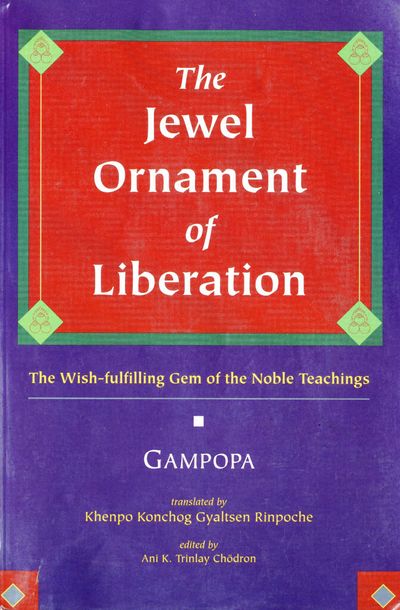- Foreword by His Holiness the 14th Dalai Lama13
- Acknowledgments14
- Translator's Introduction15
- Homage44
- Introduction45
- Part 1: The Primary Cause 47
- Chapter 1: Buddha-Nature 49
- I. Disconnected Family 50
- II. Indefinite Family 51
- III. Hearer Family 51
- IV. Solitary Realizer Family 51
- V. Mahayana Family53
- A. Classification53
- B. Definition53
- C. Synonyms53
- D. Superiority54
- E. Causal Characteristics54
- F. Marks54
- Part 2: The Working Basis 57
- Chapter 2: The Precious Human Life 59
- I. Leisure 59
- II. Endowment 60
- III. Trusting Faith 65
- IV. Longing Faith 65
- V. Clear Faith 65
- Part 3: The Contributory Cause 67
- Chapter 3: The Spiritual Master 69
- I. Reason 69
- II. Classification 71
- III. Characteristics of Each Classification 72
- IV. Method 73
- V. Benefits 75
- Part 4: The Method 77
- Introduction to Part 4 79
- Antidote to Attachment to this Life 81
- Chapter 4: Impermanence 83
- I. Classification 83
- II. Method of Meditation 84
- III. Beneficial Effects of Meditation 91
- Antidote to Attachment to Samsara's Pleasure93
- Chapter 5: The Suffering of Samsara 95
- I. All-Pervasive Suffering 95
- II. The Suffering of Change 96
- III. The Suffering of Suffering 97
- A. Hell Realm 97
- B. Hungry Ghost Realm 102
- C. Animal Realm 102
- D. Human Realms 103
- E. Demi-God Realm 108
- F. God Realm 108
- Chapter 6: Karma and its Result 111
- I. Classification 112
- II. Primary Characteristics of Each Classification 112
- A. Non-Meritorious Karma and its Result112
- 1. Taking Life112
- 2. Stealing113
- 3. Sexual Misconduct113
- 4. Lying114
- 5. Divisive Speech114
- 6. Harsh Words114
- 7. Idle Talk115
- 8. Covetousness115
- 9. Harmful Thought116
- 10. Wrong Views116
- B. Meritorious Karma and Result117
- C. Karma and Result of Unshakable Meditative Concentration118
- A. Non-Meritorious Karma and its Result112
- III. Ascription 119
- IV. Strict Result 120
- V. Increase from the Small 120
- VI. Inevitability 121
- Antidote to Attachment to the Pleasure of Peace 123
- Chapter 7: Loving-Kindness and Compassion 125
- I. The Practice of Loving-Kindness 125
- A. Classification126
- B. Object126
- C. Identifying Characteristic126
- D. Method of Practice126
- E. Measure of the Practice129
- F. Qualities of the Practice129
- II. The Practice of Compassion 129
- A. Classification130
- B. Object130
- C. Identifying Characteristic130
- D. Method of Practice130
- E. Measure of the Practice131
- F. Qualities of the Practice131
- I. The Practice of Loving-Kindness 125
- Antidote to Not Knowing the Method of Practice for Achieving Buddhahood 133
- Introduction to the Antidote to Not Knowing the Method of Practice 135
- Chapter 8: Refuge and Precepts 137
- I. Foundation 137
- A. Mahayana Family138
- B. Taking Refuge in the Three Jewels138
- 1. Classification139
- 2. Working Basis139
- 3. Objects139
- 4. Time141
- 5. Motivation141
- 6. Ceremony141
- 7. Activities143
- 8. Training143
- 9. Beneficial Effects143
- C. Pratimoksa Precepts 144
- I. Foundation 137
- Chapter 9: Cultivation of Bodhicitta 147
- II. Essence 147
- III. Classification 147
- IV. Objectives 151
- V. Cause151
- VI. From Whom You Receive It152
- VII. Method (Ceremony)153
- VIII. Beneficial Effects168
- IX. Disadvantages of Losing It171
- X. The Cause of Losing It171
- XI. The Method of Repairing172
- Chapter 10: Training in Aspiration Bodhicitta 173
- XII. Training173
- A. Training in Aspiration Bodhicitta173
- 1. Not Forsaking Sentient Beings from One's Heart173
- 2. Recollecting the Beneficial Effects of Bodhicitta174
- 3. Gathering the Two Accumulations175
- 4. Practicing the Enlightened Mind175
- 5. Rejection of the Four Unwholesome
- Deeds and Acceptance of the Four Wholesome Deeds176
- A. Training in Aspiration Bodhicitta173
- XII. Training173
- Chapter 11: Training in Action Bodhicitta 179
- B. Training in Action Bodhicitta179
- 1. Definite Number180
- 2. Definite Order180
- 3. Characteristics181
- 4. Definition181
- 5. Division181
- 6. Grouping182
- B. Training in Action Bodhicitta179
- Chapter 12: The Perfection of Generosity 183
- I. Reflection on the Faults and Virtues183
- II. Definition185
- III. Classification185
- IV. Characteristics of Each Classification185
- V. Increase 191
- VI. Perfection191
- VII. Result192
- Chapter 13: The Perfection of Moral Ethics 195
- I. Reflection on the Faults and Virtues195
- II. Definition197
- III. Classification197
- IV. Characteristics of Each Classification197
- V. Increase202
- VI. Perfection202
- VII. Result202
- Chapter 14: The Perfection of Patience 205
- I. Reflection on the Faults and Virtues205
- II. Definition207
- III. Classification207
- IV. Characteristics of Each Classification207
- V. Increase211
- VI. Perfection211
- VII. Result211
- Chapter 15: The Perfection of Perseverance 213
- I. Reflection on the Faults and Virtues213
- II. Definition214
- III. Classification216
- IV. Characteristics of Each Classification216
- V. Increase218
- VI. Perfection218
- VII. Result218
- Chapter 16: The Perfection of Meditative Concentration 219
- I. Reflection on the Faults and Virtues219
- II. Definition220
- III. Classification229
- IV. Characteristics of Each Classification229
- V. Increase230
- VI. Perfection230
- VII. Result231
- Chapter 17: The Perfection of Wisdom Awareness 233
- I. Reflection on the Faults and Virtues233
- II. Definition235
- III. Classification235
- IV. Characteristics of Each Classification235
- V. What is to be Known236
- VI. What is to be Practiced247
- VII. Result255
- Chapter 18: The Aspects of the Five Paths 257
- I. Path of Accumulation257
- II. Path of Application258
- III. Path of Insight259
- IV. Path of Meditation259
- V. Path of Perfection260
- Chapter 19: The Ten Bodhisattva Bhumis 263
- I. Definition264
- II. Significance of the Bhumis264
- III. The Reason Their Classification Is Tenfold264
A. First Bhumi 265
B. Second Bhumi 267
C. Third Bhumi 268
D. Fourth Bhumi 269
E. Fifth Bhumi 270
F. Sixth Bhumi 271
G. Seventh Bhumi 272
H. Eighth Bhumi 273
I. Ninth Bhumi 274
J. Tenth Bhumi 275
K. Buddhahood 277
Part 5: The Result 279
Chapter 20: Perfect Buddhahood 281
I. Nature 281
II. Significance of the Name 286
III. Classification 287
IV. Definition 287
V. Reason There Are Definitely Three Kayas 288
VI. Characteristics of the Three Kayas 288
VII. Special Traits 292
Part 6: The Activities 295
Chapter 21: Activities of the Buddha 297
I. Activities of the Body 297
II. Activities of Speech 298
III. Activities of Mind 299
Appendices 303
Appendix A: Dharma Lord Gampopa 305
Section 1: A Brief Account of Dharma Lord Gampopa's Life 305
Section 2: Miraculous Manifestations 323
Section 3: Gampopa's Method of Teaching 325
Appendix B: Stories Referred to in the Text 333
Sudhana 335
Sadaprarudita 340
KingAnala 348
Maudgalyayana 351
Sangharakshita 357
Nawa Chewari 362
Old Born 366
King Krika's Daughters 368
Mahadatta 371
King Bala Maitreya 379
Angulimala 381
Udayana 385
Nanda 388
Ajatashatru 393
Appendix C: Outline of the Text 397
Appendix D: A Brief Biography of the Translator 413
Titles of Works Quoted 417
Glossary 427
Notes 437
Bibliography 459
Index 467



